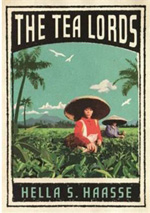
The lush verdant landscape of the Gamboeng plantation in Java dominates both the beginning and the ending of this dense family saga of Dutch plantation owners; it is truly the dominant character in Haasse's fine novel. She describes 'a drapery of dense, vivid green covering a gigantic, recumbent body' and speaks of 'the embrace of the jungle' as if it were a living, breathing human. Java's humid jungles and breathtaking mountains provide the splendid backdrop to this story of three generations of the Kerkhoven family.
The story opens in 1869 and charts Rudolf Kerkhoven's struggle to clear the jungle, nurture his crops and eventually to make a profit and pay off his investors. Rudolf aims to prove to his father, who has set up a tea plantation nearby at Ardjasari, that he can achieve great things. At first he is inundated with well meaning advice from his uncles and cousins who are vastly experienced planters. There is a palpable sense of Rudolf's frustration as he itches to get on with things his own way. And then there is the weather to contend with. I really felt the rains pouring down the fertile slopes where Rudolf Kerkhoven struggles to turn an abandoned and overgrown coffee plantation over to tea and quinine production. But by dint of hard work, the plantation is established, though much remains to be done in the years to come.
While visiting his sister Cateau in Batavia (now Jakarta), Rudolf meets Jenny Roosegaarde Bisschop from a prominent society family. They are allowed to marry even though her family has reservations about the future of Gamboeng. I sympathised a great deal with Jenny, whose life must have been so tough. She left a comfortable city life to live in the wilds amid seemingly endless drenching rain. Plantation life was grueling, particularly in the early years when there wasn't much money and Jenny and Rudolf lived in a very basic dwelling on the plantation. She also despaired every time the 'stork visited'; reliable maternity care was a long uncomfortable trek to the nearest town. In addition, Jenny is alert to things of which Rudolf is unaware; she is conscious of a strange darkness at the edge of the jungle which reminds her of her previous encounters with ancient local superstition.
Hella Haasse presents us with a snapshot of one particular colonial family, and through this gives a
view of the way in which Dutch planters harnessed the rich resources of the East Indies. She portrays
the relationships between the colonials and the local population, though I felt that the characters
of plantation workers were not depicted as clearly as those of Rudolf's family. The story is based
on the actual Kerkhoven family archive, though it is not clear how much material is used in the novel
and how much is Haasse's fiction. When I discovered this information, which is only given at the end
of the book, I wondered if it would have been better if she had written a family biography instead.
The time, place and circumstances were so fascinating that it surely would have been an excellent study.
I did Google the family name and came up with some photographs of a branch of the Kerkhoven family; I
would love to know more about them. Minor criticism apart, the book is well worth reading for the
fascinating insight it gives into a long ago way of life and for its descriptions of the sublime beauty
of the landscape of Java.

Portobello Books, Hardcover, 9781846271700
